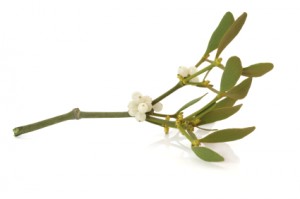
The Community in more languages
Now the forum welcomes more languages.
You'll see a green translate button in comments and discussions to turn them into English

Although mistletoe’s reputation as the sprout of love may seem like a thing of the present, it actually takes root in ancient times. The plant’s knack for staying lush and fruitful throughout the year led the ancients to use it as a symbol of fertility, and the Greek goddess Artemis wore a crown of mistletoe as an emblem of immortality. The plant also played a sacred role in the Druids’ celebration of the Winter Solstice: They would use a golden knife to cut it from the oak, and they would use it to make potions that were believed to boost procreation.
 Other civilizations saw mistletoe as a sign of peace rather than provocativeness. Ancient Scandinavians demanded that anyone who came across an enemy beneath the bloom had to put their weapons aside, give each other a hug, and agree to a truce for the rest of the day. This kind gesture could be what initially sparked the affectionate custom of kissing beneath the berries.
Other civilizations saw mistletoe as a sign of peace rather than provocativeness. Ancient Scandinavians demanded that anyone who came across an enemy beneath the bloom had to put their weapons aside, give each other a hug, and agree to a truce for the rest of the day. This kind gesture could be what initially sparked the affectionate custom of kissing beneath the berries.
But the most well-known myth behind the history of mistletoe is the legend of Baldar, the Norse god of the summer sun. When Baldar dreamed about his own death, his mother—Frigga, the goddess of beauty and love—begged all the plants, animals and earthly elements to protect him. But she forgot to talk to one plant that was high off the ground: the mistletoe. That’s when Loki, the god of mischief, fashioned a poisoned dart from mistletoe and killed Baldar, bringing darkness and cold to the entire world. But when the grieving Frigga shed tears all over the mistletoe berries, Baldar magically came back to life. Frigga was so happy that she gratefully kissed everyone who walked underneath the mistletoe, establishing it as the kissing plant we know it as today.
This little bough of berries is no ordinary plant: It doesn’t grow in the ground. Instead, it lives on, and feeds off of, the bark of trees (oaks, mostly). It even thrives during the winter, when trees shed their foliage, creating a beautiful tuft of bright green leaves and juicy berries among the bare branches. The tiny berries can be either bright red or white, and the color of its flowers can range anywhere from yellow to green. Even though the berries were once thought to be an aphrodisiac that held the soul of the tree, they’re actually quite poisonous.